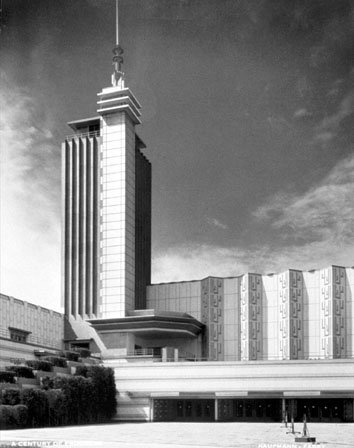 Zigzags and Speed
Stripes
Zigzags and Speed
Stripes Zigzags and Speed
Stripes
Zigzags and Speed
StripesArt Deco takes its name from the world’s fair held in Paris in 1925, the Exposition Internationale des Arts Décoratifs et Industriels Modernes, or International Exposition of Modern Decorative and Industrial Arts. At the fair, France and twenty-two other nations exhibited decorative arts in temporary buildings they designed just for the exposition. The fair’s organizers explicitly required that the wares shown be “modern”—that is, that they depart from tradition stylistically. Although the decorative arts and the pavilions in which they were exhibited varied greatly in this respect, the legacy of the fair was the new Art Deco style.
An extremely eclectic design trend, Art Deco drew on a wide variety of historical and avant-garde styles, from ancient Egyptian and Mayan architecture and decoration to Cubism, an early twentieth-century movement in the fine arts. Designers chose in a seemingly random manner from this smorgasbord of decorative motifs, simplified or stylized them, and combined them in unusual and sometimes surprising ways. Among the favorite elements of the new decorative vocabulary were sunbursts, gazelles, abstracted vegetal forms, fountains, geometric motifs, and the chevrons that gave early Art Deco its alternate name, “zigzag moderne.” The decoration was typically executed in a splendid assortment of materials, including exotic wood veneers, marble, painted terracotta, and metals. Although practitioners of doctrinaire Modernism considered Art Deco reprehensibly luxurious and self-indulgent by comparison to their own severe, socially concerned design, Art Deco stylists believed their new aesthetic was perfectly appropriate to the age that spawned such innovations as air travel, radio, the telephone, talking pictures, and the skyscraper.
Art Deco was a “total style” that designers applied to everything from tea services to skyscrapers, furniture to bookbindings, fashion design to movie sets, draperies to lipstick tubes. It was also an international style: from France, it quickly spread throughout the West and as far afield as New Zealand, South Africa, and Japan. In the United States, Art Deco was most successfully used in architecture and architectural decoration. In terms of both scale and building type, the range of its uses here was vast: it embellished grand structures like skyscrapers and bridges, and more modest buildings, such as stores, post offices, schools, banks, and gas stations. Art Deco’s most opulent expression was often found in movie palaces, where the lavishly decorated interiors completed the experience of escape offered by talking pictures.
After the onset of the depression, zigzag moderne’s extravagance became
both unaffordable and indefensible. Designers responded to economic constraints
by purging objects and buildings of abundant applied ornament in favor
of a more austere variant of Art Deco known as “streamlined moderne.” Inspired
in part by great transatlantic oceanliners like the Normandie, the new
style featured aerodynamic curves, smooth wall surfaces, and steel railing
and was often marked by the signature trio of horizontal speed stripes
that were meant to suggest motion.
Like its zigzag predecessor, streamlined moderne was a total style
that was applied to all manner of objects and structures. Typically, however,
the building types in which it was used were of smaller scale than was
true in the earlier period: gas stations, diners, bus terminals, and stores
were the favorite objects of streamlining in architecture. Fittingly, materials
used were also more humble. Facades were now clad in vitrolite (baked enamel
panels), black glass, aluminum, and plastic, and interiors were far less
sumptuous. The use of these machine-age materials reflected the fact that,
while the diminished circumstances of the depression forced a scaling-back
of the Art Deco style, that style continued to be an expression of the
essential modernity of the age.
Tracy Myers is assistant curator of The Heinz Architectural Center.
Contents |
Highlights |
Calendar |
Back Issues |
Museums |